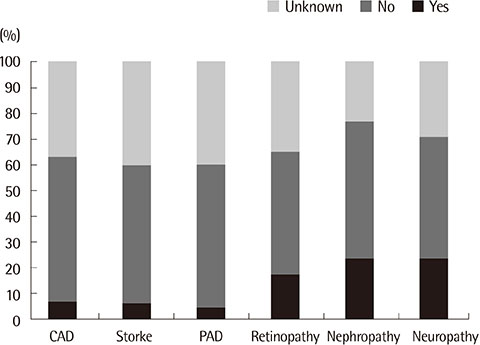Diabetes Metab J.
2014 Oct;38(5):388-394. 10.4093/dmj.2014.38.5.388.
Clinical Characteristics of Diabetic Patients Transferred to Korean Referral Hospitals
- Affiliations
-
- 1Department of Internal Medicine, Pusan National University Hospital, Pusan National University School of Medicine, Busan, Korea. injkim@pusan.ac.kr
- 2Department of Internal Medicine, Kyungpook National University School of Medicine, Daegu, Korea.
- 3Department of Internal Medicine, Chonbuk National University Hospital, Chonnam National University Medical School, Jeonju, Korea.
- 4Department of Internal Medicine, Yeungnam University Medical Center, Yeungnam University College of Medicine, Daegu, Korea.
- 5Department of Internal Medicine, Chonnam National University Medical School, Gwangju, Korea.
- KMID: 2280683
- DOI: http://doi.org/10.4093/dmj.2014.38.5.388
Abstract
- BACKGROUND
We evaluated the disease profile and clinical management, including the status of both glycemic control and complications, in patients with diabetes who were transferred to referral hospitals in Korea.
METHODS
Patients referred to 20 referral hospitals in Gyeongsangnam/Gyeongsangbuk-do and Jeollanam/Jeollabuk-do with at least a 1-year history of diabetes between January and June 2011 were retrospectively reviewed using medical records, laboratory tests, and questionnaires.
RESULTS
A total of 654 patients were enrolled in the study. In total, 437 patients (67%) were transferred from clinics and 197 (30%) patients were transferred from hospitals. A total of 279 patients (43%) visited higher medical institutions without a written medical request. The main reason for the referral was glycemic control in 433 patients (66%). Seventy-three patients (11%) had received more than one session of diabetic education. Only 177 patients (27%) had been routinely self-monitoring blood glucose, and 146 patients (22%) were monitoring hemoglobin A1c. In addition, proper evaluations for diabetic complications were performed for 74 patients (11%). The most common complication was neuropathy (32%) followed by nephropathy (31%). In total, 538 patients (82%) had been taking oral hypoglycemic agents. A relatively large number of patients (44%) had been taking antihypertensive medications.
CONCLUSION
We investigated the clinical characteristics of diabetic patients and identified specific problems in diabetic management prior to the transfer. We also found several problems in the medical system, which were divided into three medical institutions having different roles in Korea. Our findings suggested that the relationships among medical institutions have to be improved, particularly for diabetes.
Keyword
MeSH Terms
Figure
Reference
-
1. International Diabetes Federation. Diabetes atlas. 5th ed. Brussels: International Diabetes Federation;2011.2. King H, Aubert RE, Herman WH. Global burden of diabetes, 1995-2025: prevalence, numerical estimates, and projections. Diabetes Care. 1998; 21:1414–1431.3. Kim DJ. The epidemiology of diabetes in Korea. Diabetes Metab J. 2011; 35:303–308.4. Choi YJ, Kim HC, Kim HM, Park SW, Kim J, Kim DJ. Prevalence and management of diabetes in Korean adults: Korea National Health and Nutrition Examination Surveys 1998-2005. Diabetes Care. 2009; 32:2016–2020.5. Amos AF, McCarty DJ, Zimmet P. The rising global burden of diabetes and its complications: estimates and projections to the year 2010. Diabet Med. 1997; 14:Suppl 5. S1–S85.6. Harris MI. Diabetes in America: epidemiology and scope of the problem. Diabetes Care. 1998; 21:Suppl 3. C11–C14.7. Statistics Korea: 2011 statistical results about cause of death. updated 2011 Sep 19. Available from: http://www.index.go.kr.8. Gu K, Cowie CC, Harris MI. Diabetes and decline in heart disease mortality in US adults. JAMA. 1999; 281:1291–1297.9. Kim SG, Choi DS. The present state of diabetes mellitus in Korea. J Korean Med Assoc. 2008; 51:791–798.10. Lim S, Kim DJ, Jeong IK, Son HS, Chung CH, Koh G, Lee DH, Won KC, Park JH, Park TS, Ahn J, Kim J, Park KG, Ko SH, Ahn YB, Lee I. A nationwide survey about the current status of glycemic control and complications in diabetic patients in 2006: The Committee of the Korean Diabetes Association on the Epidemiology of Diabetes Mellitus. Korean Diabetes J. 2009; 33:48–57.11. Myers GL, Miller WG, Coresh J, Fleming J, Greenberg N, Greene T, Hostetter T, Levey AS, Panteghini M, Welch M, Eckfeldt JH. National Kidney Disease Education Program Laboratory Working Group. Recommendations for improving serum creatinine measurement: a report from the Laboratory Working Group of the National Kidney Disease Education Program. Clin Chem. 2006; 52:5–18.12. Park IB, Baik SH. Epidemiologic characteristics of diabetes mellitus in Korea: current status of diabetic patients using Korean Health Insurance Database. Korean Diabetes J. 2009; 33:357–362.13. Cho NH. Prevalence of diabetes and management status In Korean population. Korean J Med. 2005; 68:1–3.
- Full Text Links
- Actions
-
Cited
- CITED
-
- Close
- Share
- Similar articles
-
- A Clinical Analysis and Referral Rate on Diabetic Retinopathy in Diabetic Patients Referred for Eye Examination at a Tertiary Hospital
- Relationship between structural characteristics and hospital mortality rates on tertiary referral hospitals in Korea
- Detecting and Treating Eating Disorders in Diabetic Patients
- Characteristics of patients transferred from long-term care hospital to emergency department
- The Study on the Chief Complaints and Completion of Referral Sheets of Patients Transferred to ER


